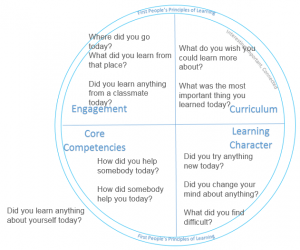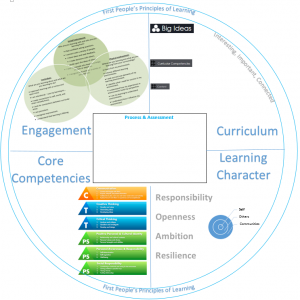Layers of Learning
September 17, 2017 - 5 minutes readAt the start of our Curriculum Night last Wednesday (Sept. 13), Vice-Principal Laura Magrath and I shared a fifteen minute presentation which had two intentions: summarize the layers of learning that happen at BICS in every subject, in every classroom, every day; and second, to provide some questions that parents could ask their children that would prompt a dialogue about these layers of learning. This blog post is a summary of that presentation.
Layers of Learning
We are in year 2 or 2+ of many provincial, district and school initiatives. While we are at a stage of continuing to do things differently (and always will be), we are also in a stage of consolidation; of ensuring that our work from the last several years stays current in our minds as we plan learning environments and learning experiences for students.
And so, to integrate these initiatives, we shared the graphic to the right with families. It summarizes four layers of learning:
- Engagement – If students are not engaged in the task, nothing else matters. Our staff use an “Engaged Learner Profile” to provide learning experience for students that engage them with (1) the curriculum, (2) the social environment (peers, school staff, guests), and (3) the physical environment. Students can reference this profile as they begin to take greater responsibility for their learning.
- Curriculum – Between units, subjects and often over years, students develop understandings of big ideas and related
curricular content and develop curricular competencies related to their subject. More simply, students understand, know, and do.
- Learning Character – Our school goal is for students to strengthen their learning character including becoming more responsible, open, ambitious and resilient. We use the “Circles of Care” framework to help students understand how they can develop their learning character; for example, being open-minded in challenging ones opinions, open-minded to the perspective of others, and open to new experiences at school and beyond.
- Core Competencies – While part of the curriculum, the Core Competencies are in a separate layer of learning quadrant as they transcend the curriculum. Core Competencies are not specific to any subject or any grade, they are instead a set of competencies that one relies upon and develops throughout life. The competencies incorporate many of the foci of our school and district: self-regulation (Personal Awareness and Responsibility Competency), critical thinking (Critical Thinking Competency), and digital access (Communication Competency).
Surrounding the quadrants is the First Peoples Principles of Learning. The Principles, set out by the First Nations Education Steering Committee, outline an approach to learning that will be inclusive of all learners. While they are “First Peoples Principles” the wisdom of these principles applies to the learning of students of all cultures.
Underlying, but visually missing from this framework, is the emotional side of learning. Happiness at school and in the classroom is foundational to learning.
Family Discussions of Learning
“How was your day?”
“Fine.”
Some children may provide more than a one word answer about their school day; most others will need a little more prompting!
By sharing with families the Layers of Learning, we hope that questions from parents/guardians can prompt a dialogue, rather than a discrete question and answer session. And in this dialogue, in addition to students sharing what they are learning about, they can also talk about how they are learning, who they are learning from, and why.
prompt a dialogue, rather than a discrete question and answer session. And in this dialogue, in addition to students sharing what they are learning about, they can also talk about how they are learning, who they are learning from, and why.
Similar to the layers of learning frame, we introduced the frame with topics related to engagement, curriculum, learning character, core competencies and the First Peoples Principles of Learning.
The layers of learning are not hierarchical. One quadrant is not deeper than any other. Each quadrant is ever-present, to varying levels of importance, in everything students do at school. Our educators do a magnificent job incorporating effective practices in their approach to learning and our hope is that the frameworks above help summarize these effective practices (layers) and provide families with a greater understanding of what students learn about and how, as well as some questions to ask about learning.
These questions are just a start. What other questions prompt a dialogue about learning? Please consider commenting below to add your response or tweet us: @bics_news.
Thank you for reading.

5 Comments